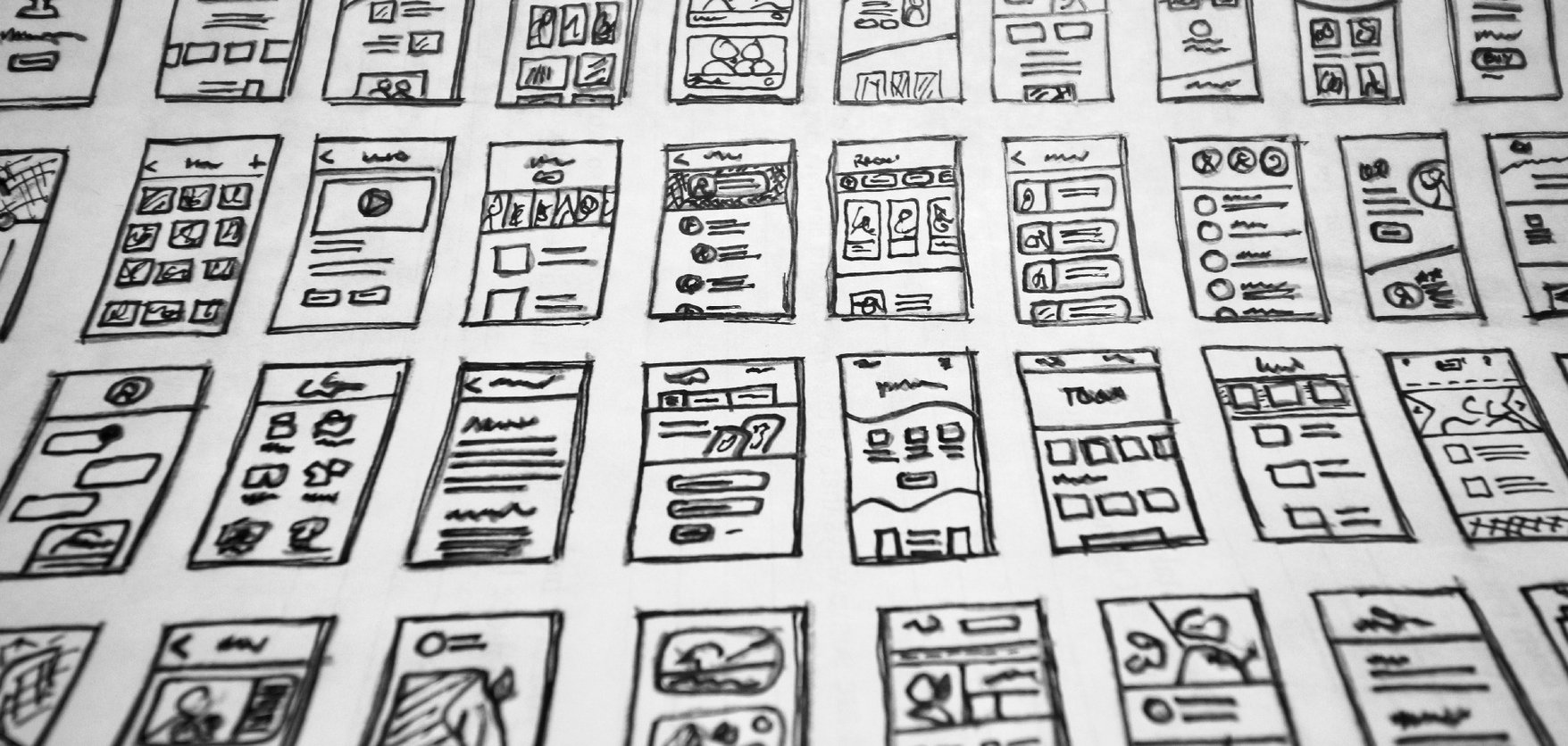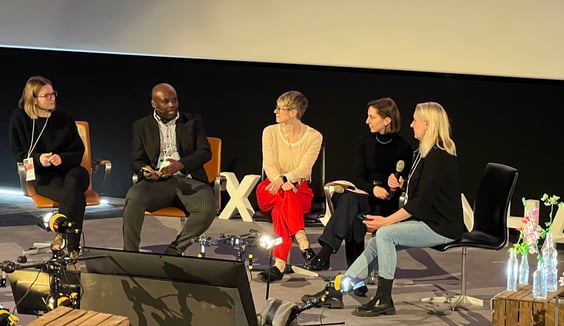UX and Design
Designing with impact: How UX Designers can drive positive change in emerging tech
05 May 2023 • 7 min read

We recently had the pleasure of hosting Edinburgh’s monthly UX Meetup at our Somerville Clubhouse; bringing together technologists and education professionals, to talk about the exceptional experiences we can work to build in emerging tech.
For those who missed it, our Design Principal Gordon Haywood, and Product Principal Elena Dumitrana were taking plenty of notes on the night, and they’re now delivering all the highlights - from the UX opportunities in Edtech, GreenTech and FemTech, to the top tips for honing your skills in those areas.
Modern challenges and opportunities for UX Designers
One of the greatest (and equally most challenging) opportunities of a career in digital and UX, is the requirement to get to grips with new things - fast.
The digital revolution has seen many waves of focus and specialisation, and in 2023 and beyond, this requires UX Designers to be constantly abreast of emerging technologies, trends and regulations, to ensure the best experience of the novel and complex. That deep sectoral understanding, combined with UX skills and a passion for the user, is where the best design comes to life.
Our UX peers began by identifying the 8 key areas they can make the biggest impact in in 2023:
EdTech - By designing intuitive and engaging platforms that address the needs of both teachers and students, researchers & designers can help to improve education outcomes and access to education worldwide. This can involve incorporating gamification, personalisation, and collaborative learning features.
MediTech - By designing usable interfaces for medical devices and equipment, UX’ers can help medical professionals provide more consistent advice, accurate diagnoses and better patient care. Designers can also help medical organisations to to assist their product teams, by incorporating virtual and augmented reality for medical training and education, or creating patient portals that allow for easy access to medical records.
FemTech - By designing user-centred services that help women track their menstrual cycles, monitor fertility, and manage menopause symptoms, designers can help to promote better health outcomes for women.
LegalTech - By designing intuitive legal research tools and platforms that help legal professionals manage cases more efficiently, UX’ers can help to improve access to justice and reduce costs for clients. This may involve incorporating AI-powered legal research tools, and creating platforms that connect clients with lawyers.
FinTech - simplifying complex financial concepts, and incorporating AI and machine learning to automate processes.
TravelTech - with the move to flexible working fuelling the digital nomad culture, there’s a critical need to retain the unique, local experiences that make destinations special, and balance this with their renewed tourism draw. UXers must understand and navigate this balance, to support and build products that create memorable experiences.
GovTech - By designing user-friendly and accessible government websites and portals, designers can help citizens engage more easily with government services and increase transparency and accountability. This requires products and services that are accessible, transparent, and easy to use for all, and could involve chatbots, voice assistants, and other AI/ML tools to streamline government services.
GreenTech - When it comes to resources and energy consumption, gaining a better understanding of customer needs and behaviours will enable the design and development of products that integrate with national technology platforms, and work seamlessly across user devices. Designers have an opportunity to make a huge difference in this space, bringing renewable power to people and making its management as accessible as possible, whilst supporting national sustainability strategies and goals.
Keeping up with emerging tech with the right learning strategy
Learning doesn’t end after formal education; it should be a lifelong process. The world around us is constantly evolving, particularly in the digital space; and maintaining the skills and knowledge to navigate that evolving world is critical to individual and societal success. Modern learning comes in many forms, but central to lifelong learning is a self-led strategy with measurable goals and constructive reflection. In a room full of UXers, our peers shared their greatest tips for keeping up to speed with emerging tech.
Know your goals: Before you start learning something new, it's important to have a clear goal in mind. Knowing what you want to achieve can help you stay focused and motivated throughout the learning process.
Break it down: Learning a new skill or topic can be overwhelming if you try to tackle it all at once. Break it down into smaller, more manageable chunks, and tackle them one at a time.
Find the learning approach that works for you: Everyone learns in different ways, so it's important to use different learning methods to find what works best for you. Some people learn best through reading, while others may prefer hands-on activities or watching videos. You can “learn” what type of learner you are to plan that out, by taking a simple questionnaire.
Practise, practise, practise: Repetition is key to learning and retaining new information. As a UX’er, practise what you've learned regularly to help solidify your understanding and build your skills.
Ask for feedback: Feedback is essential for learning and growth. Seek feedback from others who have expertise in the area you're learning or from peers who are also learning the same thing. Build your professional network to include EdTech, FinTech, etc professionals, as well as UX peers.
Try ‘futures thinking’: Curiosity is a powerful driver of learning about how design can support emerging sectors. Ask questions, seek out new information, and approach learning with a sense of curiosity and wonder.
Get organised: Keep track of what you're learning and the progress you're making. This can help you stay motivated and focused, and make it easier to track your progress and celebrate how far you’ve come over time.
How to fast-track sector learning
Whilst ‘lifelong learning’ is essential, its indefinite nature means we can sometimes miss out on the high-fives and milestones of how far we’ve come. It also means that the timescales we have to get up to speed with new sector technologies can feel indefinite. But there are ways to fast-track your learning, to feel that 'big bang' push we often need to spark inspiration.
Attend industry events and conferences: An excellent way for designers to learn about the latest trends, technologies, and challenges in a specific sector is by attending industry events and conferences. UX talks, workshops, meet-ups and networking events are an ideal opportunity for you to connect with industry experts and gain a deeper understanding of the sector they're designing for.
Conduct your own research: User research is the foundation of UX design. Conducting user research within a specific sector can help UX’ers better understand the pain points, needs, and goals of users within that sector. By conducting interviews, surveys, and user testing, you can gain valuable insights into the user experience and design solutions that are tailored to their needs.
Read industry publications and blogs: Reading industry publications and blogs can be a great way to stay up-to-date with the latest news, trends, and best practices within a specific sector. By regularly reading relevant publications and blogs, you can gain a deeper understanding of the challenges and opportunities in the sector and design solutions that meet the needs of users.
Collaborate with subject matter experts: Collaborating with subject matter experts can be an effective way for UX’ers to deepen their knowledge of a specific sector. By working closely with experts in EdTech, FinTech, GovTech, or health, you can gain a deeper understanding of the needs and expectations of users within that sector and design solutions that meet their needs.
Learn from your peers: Participating in sector-specific communities, such as online forums, social media groups, or meetups, can be an effective way for designers to connect with others in their field and gain insights into the challenges and opportunities within a specific sector. By participating in these communities, you can learn from others' experiences, share knowledge and expertise, and deepen your understanding of the sector you're designing (or aspiring to design) for.
Volunteer your time: Either individually, or using one of the emerging community volunteer models like Scottish Tech Army or Inspiring Scotland’s Specialist Volunteer Network. This is a brilliant way to step out of your comfort zone, explore new industries and acquire sector-specific skills.
Consider a digital apprenticeship: These are not just for 17 year olds! Upskill and reskill is the mantra of the modern day, and digital apprenticeships are too often an under-utilised route to a new skillset or career path. Make use of EdTech too, exploring the many platforms and resources that offer a growing list of UX specialist programmes - eg. Coursera.
Remember, some design ‘good practice’ is universal, but designing for emerging sectors and technology means accepting that sometimes we do need to reinvent the wheel, and that can be a great thing. There may also be opportunities to cross-pollinate the 'good' from elsewhere e.g. gamification and incorporating fun into products, which is proven to help people learn faster and retain information longer. Just remember to test with real users!
Over the past 3 years, Gordon and Elena have been involved in a range of collaborative initiatives; from civic design endeavours with the Scottish Tech Army and Inspiring Scotland’s Specialist Volunteer Network, to advising SMEs in emergent technologies; all looking at ways to close the digital skills gap and improve our national economic outlook.
Looking to get your UX team up to speed on the latest tech? Get in touch with our team today.




